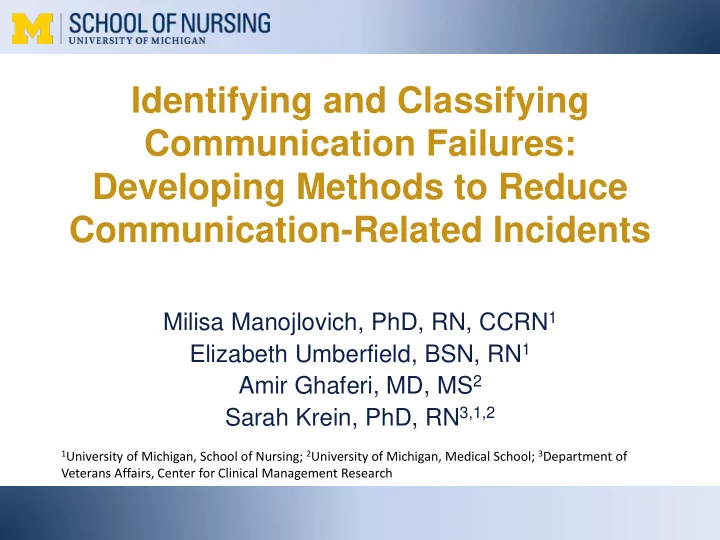

Identifying and Classifying Communication Failures: Developing Methods to Reduce Communication-Related Incidents Milisa Manojlovich, PhD, RN, CCRN 1 Elizabeth Umberfield, BSN, RN 1 Amir Ghaferi, MD, MS 2 Sarah Krein, PhD, RN 3,1,2 1 University of Michigan, School of Nursing; 2 University of Michigan, Medical School; 3 Department of Veterans Affairs, Center for Clinical Management Research
Acknowledgement • Risk Management Department
Background • Communication failures and patient safety • “In the moment” vs. retrospective methods • Characterizing and learning from failures • Hospital incident reports – Can they be used to identify failures?
Study Purpose To develop and apply a classification method to identify and characterize communication failures between nurses and physicians from incident reports.
Study Design • Qualitative descriptive design • Large Midwest tertiary care health system • Electronically captured incident reporting system (RL6: Risk)
Population Studied 28,893 reports submitted 16,165 reports to consider for analysis 698 reports after filters applied (communication failure, RN/MD, adult) 160 hand-selected RN-MD communication failures
Conceptual Framework: Rhetoric What is Rhetorical Why Rhetoric? Principles Rhetoric? • The study of • All communication has • A rhetorical the intended/actual effects. approach relationship shifts • All communication is emphasis between motivated by the need away from the communi- to identify with an message to audience to “achieve cation and its action arising common ground effects. from it. required for a productive exchange”
Halverson et al. (2011) Classification Failure Type Definition Error of Content Information in the message was inaccurate, missing, or unclear Error of Occasion Something in the physical or temporal situation/context of the message was wrong Error of Purpose Unresolved goals (implicit or explicit) of the communication event Error of Audience Appropriate individuals were not participating Error of Omission Communication was absent Error of Inappropriate Communication consisted of offensive remarks or Communication unreasonable requests
Principal Findings • The 160 reports involved at least one communication failure. • 40 reports (25%) contained more than 1 communication failure. – In the 160 reports, there were 209 failures. • Errors of omission were the most common (28%). • Of the 160 reports, 101 named adverse outcomes: – Delays in care (37.6%) – Actual or potential for physical harm (20.2%) – Dissatisfaction (9%)
Error of Content Definition Brief Example from Text Information in the Nurse on unit was given report message was from OR on a patient arriving to inaccurate, the unit and was told that they missing, or unclear. were only on propofol and insulin. Pt arrived with vasopressin, norepinephrine, and milrinone in addition to the propofol, and insulin.
Error of Occasion: Physical Definition Brief Example from Text Something in the Per night RN: the following physical or morning orders were never temporal entered. However, they were situation/context of written at 2159 but were signed the message was and held (the night nurse didn't wrong. see them).
Error of Occasion: Temporal Definition Brief Example from Text Something in the An insulin infusion’ initiated from instruction from endocrinology to nursing physical or staff and patient without an actual order temporal being placed in chart. Advanced practice situation/context of provider attempted to get information the message was from endocrinologist, but due to delay in hearing back no order was placed until wrong. the following morning from recommendations were documented the evening before.
Error of Purpose Definition Brief Example from Text • There were On multidisciplinary rounds I (RN) brought up to attending and CCMU unresolved goals fellow that PICC could be a source of (implicit or explicit) infection and that we should consider of the removing it. MDs felt that it wasn't communication necessary given that pt. has VAE and blood cultures have been negative. I event. explained my rationale for concern given vital signs and +SIRS criteria. At this time the line remains in place.
Error of Audience Definition Brief Example from Text • Appropriate Mr.*** was put on call for the OR and brought to preop. Pt was in preop for 2 hrs individuals were with family. I called the OR charge nurse to not participating. see what the delay was with pt's case. She stated she was just told that the pt was cancelled. Apparently the service had decided earlier that am that they were not going to do the procedure. No communication with OR, preop or the pt that he was cancelled. Pt and family were not happy with the situation.
Error of Omission Definition Brief Example from Text • Communication Physician NOT notified of was absent. patient's T38 at 7pm. [MD] Tried to tell charge nurse, no answer. Paged nurse to notify physicians of abnormal vital signs, no response.
Error of Inappropriate Communication Definition Brief Example from Text • Communication I inadvertently contaminated the corner of a sterile table. I immediately notified the scrub consisted of and told him that the towels were offensive remarks contaminated and his gloves and pen were or unreasonable too. He shouted, "No they're not!" and threw requests. the pen on the table and threw the towels on the floor . He changed his gloves but continued to use the pen. I asked him to stop, but he shouted that he was done talking to me and said he was going to write this up as anesthesia is always contaminating tables and he has to "watch us like a hawk.”
Conclusions/Implications • Our adapted failure classification system is useful in identifying types of failures and contributing factors. • Incident report data could be used to make recommendations to reduce future failures. • Using these methods, we can design and test interventions to improve communication.
Thank you!! Questions? Comments? mmanojlo@umich.edu @mmanojlo
Recommend
More recommend